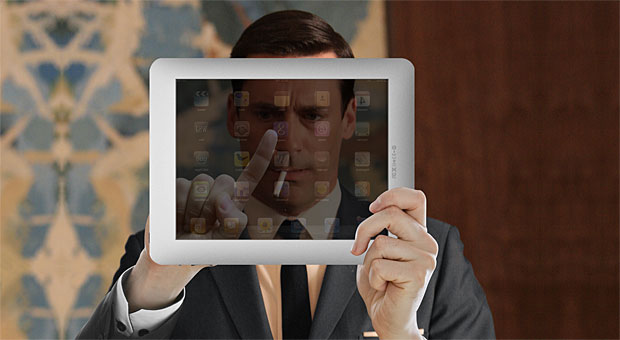Fooling around with the Tron: Legacy iAd – the first iAd for Apple’s iPad – I wondered what Don Draper would make of the new advertising format. (Not a curmudgeonly 90-year-old Don Draper of today, who’d probably be more concerned with those loud teens down the block than the latest whatsit. I mean an in-his-prime, […]
Fooling around with the Tron: Legacy iAd – the first iAd for Apple’s iPad – I wondered what Don Draper would make of the new advertising format. (Not a curmudgeonly 90-year-old Don Draper of today, who’d probably be more concerned with those loud teens down the block than the latest whatsit. I mean an in-his-prime, boozing, smoking and Kodak Carousel-branding Don Draper.)
“Advertising is based on one thing,” Draper said in Mad Men’s first season. “Happiness. And you know what happiness is? Happiness is the smell of a new car. It’s freedom from fear. It’s a billboard on the side of the road that screams reassurance that whatever you are doing is okay. You are okay.” The role of advertising in our lives and what it strives to achieve has changed since Draper’s time. The core is perhaps the same – to reach someone in a manner that speaks to them – but the idea of ads telling you you’re “okay” has evolved, as has the meaning of “happiness,” via advertising. Today, successful ads achieve a broader emotional engagement in a way that excites people honestly and intellectually. More than something material, they give you something worthwhile. So what does it mean for people seeing advertisements that they can reach out and physically manipulate, touch and interact with?
iAds are the posterchild of immersive HTML5 ads – the advertising format on all touch screen mobile devices – and this new format can revolutionize advertising altogether. iAds made their debut last year on the iPad’s smaller cousins, the iPhone and iPod Touch, with several top-shelf brands (including Nissan, Audible.com, and Campbell) making creative entries. They first appear as banners in iApps, can be clicked and activated, and then exited at any time. The hook (and innovation) is that that they’re not passive ads; users interact with them physically via the touch screen and engage with them on their own terms.
iAds and HTML5 ads can make the user a part of the advertisement like never before, and that is genuinely exciting in a, “Let’s create something no one has ever seen before and make a real connection” way. As a gamer, I think of how Nintendo’s seemingly simple innovation of user interaction changed how we relate to video games forever, stirring the imagination in new ways. I watched my friend’s 85-year-old grandfather play Wii Bowling, probably the first time he’d “bowled” in 30 years, invigorated with each strike; I smiled as my uncle played Wii Baseball, swinging the remote like he was back in Brooklyn playing stickball. They were honest moments of joy.
iAds and HTML5 ads can have the same impact on how we experience advertisements. The Tron iAd lets you spin, with a flick of the wrist, a Tron-inspired wheel that takes you to movie trailers, a map with theaters near you playing the movie (the most usable, personalized feature), soundtrack samples and more. Nissan’s iAd for the Leaf, a 100% electric car, makes use of all of the iPhone’s functionality – tapping, sliding, tilting, and even shaking – to give users a unique, in-depth experience. You can rotate the car; see inside it; watch a high-quality video ad; reserve one or compare it, dollar-by-dollar and mile-by-mile, to other cars. It’s almost an app in disguise, and it’s a delight.
So what would everyone’s favorite ad exec think of iAds? Can they tell you you’re okay and bring about happiness by today’s standards? I think Don would argue that they have more potential to accomplish this than maybe any other ad format that came before. The Nissan iAd, through the experience of exploring the car and the message of just how different and innovative the Leaf is, does tell you you’re okay. It tells you you’re taking a step into something important, social and worthwhile. That is happiness. Imagine what Draper could have done with this technology while working on the Kodak Carousel? Maybe he’d give users the chance to spin it themselves, upload their own photos instantly, and share them – and the stories behind them – with friends.
iAds and HTML5 ads represent change. “And let’s also say that change is neither good nor bad,” Draper said in the show’s third season, “it simply is. It can be greeted with terror or joy, a tantrum that says, ‘I want it the way it was,’ or a dance that says, ‘Look, something new!’” My guess is, he’d be excited by the “something new” that iAds bring: the chance to connect with people on even deeper levels than ever before.
